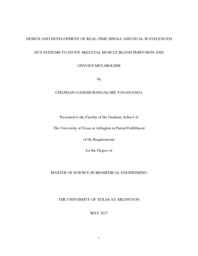
ATTENTION: The works hosted here are being migrated to a new repository that will consolidate resources, improve discoverability, and better show UTA's research impact on the global community. We will update authors as the migration progresses. Please see MavMatrix for more information.
Show simple item record
| dc.contributor.advisor | Liu, Hanli | |
| dc.creator | Bangalore Yogananda, Chandan Ganesh | |
| dc.date.accessioned | 2023-09-11T15:22:54Z | |
| dc.date.available | 2023-09-11T15:22:54Z | |
| dc.date.created | 2017-05 | |
| dc.date.submitted | May 2017 | |
| dc.identifier.uri | http://hdl.handle.net/10106/31705 | |
| dc.description.abstract | The aim of this study was to utilize Diffused Correlation Spectroscopy (DCS) to design and develop real-time single and dual wavelength systems and assess the physiological impacts of exercises on blood perfusion. The study consisted of 4 parts. Part 1 was to Re-design and develop a real-time single wavelength DCS system, part 2 was to validate this system by a cross validation method with the help of a concurrent study alongside Doppler ultrasound. Part 3 was to design & develop a real-time dual wavelength DCS system and part 4 was to validate the dual wavelength DCS system.
DCS is a developing non-obtrusive procedure to test profound tissue hemodynamics. DCS utilizes time-averaged intensity autocorrelation function for the fluctuations caused by moving scatterers (RBCs) in natural tissue. I introduced a software based autocorrelator framework to finish the securing and handling parts. I led approval considers on an intralipid phantom and human forearm. Both the studies demonstrated smooth decays which aid in showing signs of an improved fitting and subsequently more exact blood flow index (BFI). I appear that the software based autocorrelation framework can be a contrasting option to the traditional equipment based correlators in DCS frameworks with advantages, for example, adaptability in raw photon count information handling, data processing, minimal effort and low cost.
Coordinate nonstop noninvasive estimation of neighborhood muscle blood stream in people stays constrained. Routine estimations of appendage blood stream, for example, Doppler ultrasound or venous impediment plethysmography, measure changes in mass channel stream and don't give provincial data. Near infrared diffused correlation spectroscopy (DCS) is a rising system for non-intrusive estimation of neighborhood muscle blood stream at the microvascular level. To better comprehend the qualities and restrictions of this novel approach, I played out an approval think about by looking at muscle blood stream changes measured by DCS and Doppler ultrasound during a small exercise.
The design and development of a real-time dual Wavelength DCS system consisted of 2 laser sources. An optical switch was used to toggle the light between laser 1 and laser 2. With this dual wavelength system conc. of HbO (Oxy hemoglobin) & conc. of Hb (de-Oxy hemoglobin) can be calculated along with the other parameters like rBFI (relative blood flow index), dOD (delta Optical density) and total intensity of the detected photons. I led validation studies on intralipid phantom and human forearm (arm cuff measurement). Both the studies demonstrated smooth decays which aid in showing signs of an improved fitting for rBFI and conc. of HbO (Oxy hemoglobin) & conc. of Hb (de-Oxy hemoglobin) was also obtained in real-time. | |
| dc.format.mimetype | application/pdf | |
| dc.language.iso | en_US | |
| dc.subject | DCS | |
| dc.subject | Design and Development | |
| dc.title | DESIGN AND DEVELOPMENT OF REAL-TIME SINGLE AND DUAL-WAVELENGTH DCS SYSTEMS TO STUDY SKELETAL MUSCLE BLOOD PERFUSION AND OXYGEN METABOLISM | |
| dc.type | Thesis | |
| dc.date.updated | 2023-09-11T15:22:54Z | |
| thesis.degree.department | Bioengineering | |
| thesis.degree.grantor | The University of Texas at Arlington | |
| thesis.degree.level | Masters | |
| thesis.degree.name | Master of Science in Biomedical Engineering | |
| dc.type.material | text | |
Files in this item
- Name:
- BANGALOREYOGANANDA-THESIS-2017.pdf
- Size:
- 4.771Mb
- Format:
- PDF
This item appears in the following Collection(s)
Show simple item record


